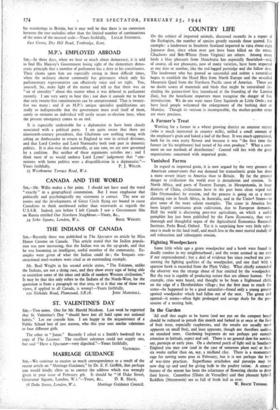COUNTRY LIFE
ON the subject of imported animals, discussed recently in a report of the Ecologists, the number of species greatly exceeds those quoted. For example: a landowner in Southern Scotland imported in 1904 about eight Japanese deer, since when over goo have been killed on the estate. Chuckaws and Bob-Whites (from Virginia) are others. Among many birds a blue pheasant from Manchuria has especially flourished—and, of course, all our pheasants, now of many varieties, have been imported at one date or another, like the red-legged partridge and the fallow deer. The landowner who has proved so successful and ardent a naruraliser hopes to establish the Hazel Hen from North Europe and the so-called Mountain Quail from the Northern Pacific coast of America. There are no doubt scores of mammals and birds that might be naturalised (in- cluding the guinea-fowl first introduced at the founding of the London Zoo), but the beneficent importers must recognise the danger of free introduction. We do not want more Grey Squirrels or Little Owls ; nor have local people welcomed the enlargement of the barking deer or Muntjac. Though its venison is incomparable, the market-garden crops are more precious.
A Farmer's Treat
Working for a farmer in a wheat growing district an amateur recruit (who is much interested in country mills), milled a small amount of the employer's grain and baked a loaf of the flour. It was much appreciated, both for its own nutty flavour and because it was " the first time the farmer (or his neighbours) had tasted of his own produce." What a com- ment on our methods of distribution! Control still lies with the great organisations concerned with imported grain.
Vanished Farms
In regard to imported grain, it is now argued by the very greatest of American conservators that our demand for. transatlantic grain has done a more severe injury to America than to Britain. By far the greatest danger to civilisation the world over is denudation and erosion. In North Africa, and parts of Eastern Europe, in Mesopotamia, in huge districts of China, civilisations have in the past been clean wiped out (like Ozymandias) by erosion, and the process is going on at a most alarming rate in South Africa, in Australia, and in the United States—to give some of the more salient examples. The cause in America has been largely continuous grain cultivation, due to European demands. Half the world is discussing post-war agriculture, on which a useful pamphlet has just been published by the Farm Economist, that very thorough and thoughtful organ of the Agricultural Economics Research Institute, Parks Road, Oxford. Yet it is surprising how very• little refer- ence is made to the land itself, and much less to the most mortal malady of soil exhaustion and subsequent erosion.
Fighting Woodpeckers Some little while ago a green woodpecker and a hawk were found in deadly combat in my neighbourhood ; and the event seemed to me rare if not unprecedented ; but a deal of evidence has since reached me con- cerning the fighting qualities of the woodpecker, and one duel With a sparrow hawk is recorded from the Plym Valley. What chiefly astounded the observer was the strange shout of fear emitted by the woodpecker. But the race is capable of producing noises that are almost human. For example, cries were heard, and thought to be from a frightened child, on the edge of a Herefordshire village ; but the first man to reach the scene—he happened to be a good naturalist—found only a young greater spotted woodpecker which had fallen out of the nest. The green and spotted—it seems—often fight prolonged and savage duels for the pos- session of a nesting hole.
In the Garden
*All stuff that ought to be burnt (and not put on the compost heap) should be reduced to potash this month and forked in at once at the foot of fruit trees, especially raspberries, and the results are usually most apparent on small fruit, and least apparent, though not therefore useless, on standard trees. Gardening beginners do not perhaps pay enough attention to latitude, aspect and soil. There is no general date for sowing, say, parsnips or early peas. On a sheltered patch of light soil in Southern England you may sow (and in the case of tomatoes plant out) at least six weeks earlier than on, say, a midland clay. There is a momentary rage for sowing some peas in February, but it is not perhaps the be-t of war-time practices. Superfluous artichokes and parsnips may be now dug up and used for giving bulk to the poultry ration. A strange feature of the season has been the reluctance of flowering shrubs to drop their leaves. Ceanothus (Gloire de Versailles) and that pleasant hybrid Buddleia (Meycrensis) are as full of fresh leaf as ever.
W. BEACH THOMAS.


























 Previous page
Previous page